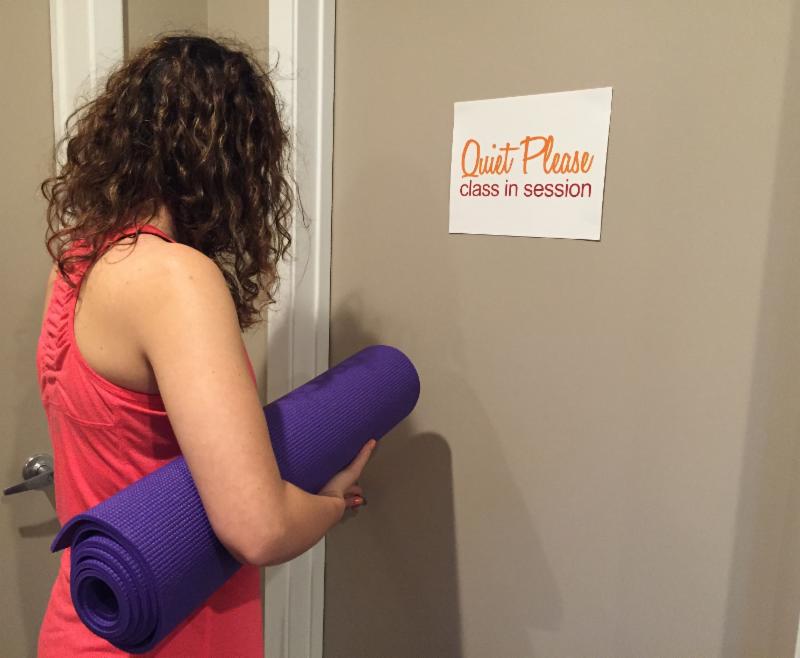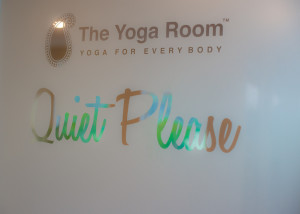Have You Been Unintentionally Stealing?
Earlier this week we made a new-ish student pretty upset with us. She arrived several minutes late for a class and the staff at our front desk would not let her into the class. Of course we never want to exclude our students from class or make them angry (after all, our mission is Yoga for EveryBody), but we do want to protect the sacredness of the time and space of the yoga class.
Our Yoga Etiquette guidelines on our website recommend that students “Arrive a few minutes before your class. Late arrivals are disruptive to the teacher and the students who have set down their mats and settled in for practice.”
Given the increasing number of late arrivals we’ve had in recent weeks, I think it’s time to shine a light on this guideline and explain in more detail why it’s so important that everyone arrive on time.
 According to the yogic concept Asteya, being late for an appointment or meeting is a form of stealing. It’s stealing people’s time. Allow me to explain…
According to the yogic concept Asteya, being late for an appointment or meeting is a form of stealing. It’s stealing people’s time. Allow me to explain…
Stealing from Classmates
When people come to a yoga class, they have planned and committed time for their yoga practice, for their self-care. One of the main reasons people come to yoga is to restore some peacefulness into their hectic lives. When a person arrives late to class, they create disruption and unintentionally steal from their classmates’ peaceful experience.
Depending upon how late the person arrives, their entry into class may have different repercussions.
If the class has already begun, everyone has already set up a space for their mat and props. When a person comes in late, depending on the size of the class, some classmates may need to stop their practice, get up, and reposition their mat and props to make space for the late person.
A late arrival might interrupt the centering practice. That means that just as people are doing the work of shifting their awareness out of their heads and settling into their bodies, the late person’s arrival, even if they try to minimize disruption, can abruptly bump their classmates’ awareness back into their minds.
And from a more literal perspective, when a person arrives late they are stealing from their classmates’ financial investment in the class. Our classes are defined to be 60 minutes long (for the most part), and people expect 60 minutes of instruction.
When a person arrives late, their classmates are disrupted, the teacher’s train of thought is disrupted, thus disrupting the quality and flow of the class. As a result, unfortunately, the students do not receive the full 60 minutes of instruction they expected.
Stealing from Themselves
A student’s late arrival might mean that they come into class when the yoga practice has already begun. If this is the case, the late student is also stealing from their own experience.
The teacher may not have time to check in with the late student to find out about any injuries, issues, or conditions they may have that day, so the teacher may not provide a practice that is 100% appropriate and beneficial.
Or, the late student may miss the warm up and need to jump into the practice at a point when the poses have become inappropriately challenging for a person who just walked in the door. This may, unfortunately, lead to a less-than-great practice or even an injury.
Stealing from the Teacher
When a student comes in late for class, it can cause a lot of stress for the teacher. First, the teacher might need to help the latecomer find a spot for their mat. Then, in order to help the student begin their practice without further delay, and in an effort to minimize disruption, the teacher may need to fetch the student’s props *while* they continue teaching *and* keeping an eye on all the students to make sure they’re understanding the instructions and their alignment is correct and safe.
The teacher may worry that the late student has not had time to properly warm up and is entering the practice at a point when the poses have already become challenging. They may be concerned that they do not know whether the student has any injuries, issues, or conditions that may affect their practice. All of these concerns and efforts steal the teacher’s peace.
If the teacher can find time to check in with the student, they may realize that the practice they planned and began teaching is not appropriate for the late student, and they may have to scramble to change their lesson plan mid-class. This can be extremely challenging and stressful.
I can tell you from personal experience that on a few occasions when I’ve taught a class where many of the students are dealing with serious issues in their bodies (knee replacements, herniated discs, carpal tunnel syndrome, fibromyalgia, recovering from a car accident), and I’ve figured out a lesson plan and begun teaching a practice that is appropriate and beneficial for everyone in the class, if a person comes in late and they have a new issue I need to take into consideration, it can completely throw off the rest of the class.
Without an opportunity to stop, collect my thoughts, and replan the class, the rest of the practice feels like a disaster, a random assortment of yoga poses that really doesn’t serve anyone. The quality of the instruction really suffers, and you can be sure that this kind of situation will really steal the teacher’s peace.
So…
Having students arrive late for class is a really difficult situation. Of course we want to be welcoming and inclusive, but we also want to protect everybody's experience. And in order to do that we need to set some clear expectations.
Please make every effort to arrive early enough that you can set down your belongings, check in, use the restroom if needed, drink some water if you want to, select the props you want for class, and be on your mat and ready to begin at the time the class is set to start.
Usually, arriving 10-15 minutes before your class time is perfect. If you have a little extra time you can relax on your mat for a few minutes and start getting present for your practice.
If it’s your first visit to the studio and you have trouble finding us, or if you are a regular student who has gotten stuck in unexpected traffic or have had some other unforeseen issue, and you know you’re going to be late, please give us a call (512-318-2112) if you can so that we can be prepared for your late arrival.
And please know that we absolutely cannot allow anyone to enter a class more than 5 minutes late because we want to make sure we’re providing a high quality experience and keeping you safe.
And by the same token, please plan to stay until the end of class. Packing up and leaving before the end of class causes the same kind of disruption as someone arriving late.
We very much appreciate your understanding on this, and we look forward to seeing you soon!

XO, Zelinda
P.S. We'd love to hear from you on this. Please feel free to leave a comment here or send us an email if you'd prefer to send a private note.
Yoga Etiquette
When I was a young girl I loved to read etiquette books. Really. I remember reading once that the purpose of etiquette is not to make judgements about people or make them feel uncomfortable, but rather to provide a set of guidelines so that people know how to conduct themselves in any situation so that they can feel comfortable and confident. What does this have to do with yoga? Well, remember the first time you walked into a yoga studio? I bet you had a lot of uncertainties... Am I wearing the right clothes? Why is everyone so quiet? Where do I put my stuff? What equipment do I need? What if I can’t do the poses?
 All this uncertainty probably made you feel uncomfortable and nervous, which is exactly the opposite of how I want people to feel when they come to The Yoga Room. So I'd like to share some thoughts about the etiquette of yoga, so that both new and experienced yogis will feel confident and completely at ease at The Yoga Room or any other studio they may visit.
All this uncertainty probably made you feel uncomfortable and nervous, which is exactly the opposite of how I want people to feel when they come to The Yoga Room. So I'd like to share some thoughts about the etiquette of yoga, so that both new and experienced yogis will feel confident and completely at ease at The Yoga Room or any other studio they may visit.
Arrival & Departure Time
Plan to arrive 10-15 minutes before your class begins. This gives you enough time to put away your personal belongings, find a spot for your mat, collect any props you may want or need for class, fill out paperwork (if you're new to the studio) and pay for a class pass if you need to.
If you arrive a few minutes late due to an unforeseen circumstance, ask the desk staff if you’re too late to join the class. If you’re just a couple of minutes late you may still be able to join (enter quietly to minimize disruption as much as possible), but if you’re more than a couple of minutes late, you may not be let in because walking in late creates a distraction for both the students and the teacher.
Stay in the room until the end of final relaxation. People come to yoga to relax, and if you get up and leave in the middle of practice it causes disruption to the flow of class and stress for the teacher and students. If you feel that you need a break, you can certainly do a relaxation pose at any time. You can sit or lay down, or rest in child’s pose or on all fours.
If you must leave the room to go to the restroom, try to exit and re-enter quietly to minimize disruption.
Occasionally a situation may arise where you'll need to leave class early. Maybe you are a health professional and you're on call or maybe you have an unforeseen emergency. In any case, quietly communicate the situation to the teacher and exit with minimal disruption. Leave your props in place and the teacher will take care of them later.
Personal Belongings
When you come into our lobby, remove your shoes and place them on the shoe shelf. We don’t wear shoes in the studios for a number of reasons: so that we can exercise the muscles in our feet and so that the floor stays as clean as possible. Since we sit and lay on the floor, it's especially important to keep it free of mud, dirt, and other debris that may have stuck to the soles of your shoes.
Personal belongings such as jackets, purses, wallets, glasses, etc., may be placed in the cubbies in your class’s studio.
Unless you are a health professional who is on call or a new mom leaving her baby with a sitter for the first time or you have some other potential emergency situation, leave your cell phone in your car, or make sure it is turned off or switched to airplane mode. When a phone rings or vibrates during class, it is disruptive to the teacher and the students, and embarrassing to the phone's owner who has to stop their practice to silence it.
Clothing
We explore the body's range of motion in every yoga class, so it's good to wear modest clothes that can move with you. Yoga or athletic pants, capris, and long or medium length shorts, paired with a t-shirt or tank top are appropriate.
A special note about yoga pants and tights: Many styles of tights are in fashion right now, and it's a good idea to know the differences between yoga pants and tights. Tights thinner and are are designed to be worn with a long top or a short dress because they become sheer when stretched. Thinner yoga pants can also become sheer when they are stretched.
A good test to check the opacity of your pants is to stretch them over your outstretched hand. If you can clearly see your hand through the pants, during your yoga practice those pants will likely reveal parts of your anatomy that you typically would want to keep private.
Chewing Gum
Chewing Gum during yoga practice disrupts your breathing and creates distraction from your practice. It's a good idea to discard your gum in the waste bin before practice.
Perfumes and Body Odor
Many people are sensitive or allergic to perfumes, colognes, and scented lotions. Out of respect for your fellow practitioners (and your teacher) who will be breathing consciously, intentionally, and deeply, near you, for an hour, please arrive at the studio clean and free of body odor and refrain from wearing any scents. Even if you think your perfume smells mild and nice, it can still be offensive to others who have a sensitive sense of smell.
If you are a smoker, please refrain from smoking for a few hours before attending yoga practice.
Respect for Others
People who attend classes in a yoga studio often consider it as a place to get away from the stresses in their lives and to practice quiet relaxation. In the time before your class begins, arrange your space quietly, speak in a quiet tone, and be respectful of your fellow practitioners’ space.
Yogis often regard their yoga mat as a sacred space for practice and relaxation. Do not step on another person's mat, especially if you are wearing shoes. We lay our faces and bodies on our mats, so we want to make sure to keep them clean.
Practice silence during class. Silence encourages mindfulness and awareness, which are important tools in one's yoga practice. Sometimes the teacher will pose a hypothetical question during class in an effort to help the students tune into sensations in the body. Answer these questions silently in your mind.
Sometimes the teacher will ask a direct question in order to gain feedback or encourage sharing about a particular pose or situation. In this case it is perfectly fine to respond. In some situations, excessive talking during class can be a distraction for the teacher, who is working to lead a cohesive, beneficial, safe, and serene practice for all the practitioners.
Please keep in mind that these are not hard and fast rules, but rather guidelines to consider when deciding how little or how much is appropriate to share during the yoga practice.
Yoga Props and Equipment
The Yoga Room provides bolsters, blankets, straps, blocks, sand bags, eye pillows, and other props for everyone to use. We also have mats available for rent.
We clean all the props on a regular schedule. We appreciate when you take a minute to neatly fold your blanket and put your props back on the shelves as you found them.
If you borrow a rental mat, we appreciate when you take a minute after practice to sanitize the mat with the provided mat spray and towel. After you give the mat a minute to dry, please roll it up and replace it in the basket. If another class is coming in, please bring the mat to the lobby staff so that they can finish taking care of the mat.
Children
Sometimes people ask at what age it is appropriate to bring children who are interested in yoga to a yoga class. The answer is that it depends on the child.
Given that the yoga studio is a place of calm and relaxation, it is important that all participants, children included, are able to focus and follow instructions for the hour-long class. It is important that no one cause distraction to anyone else. If children at interested in attending a yoga class, they should be able to follow all the etiquette guidelines described here.
It is not appropriate to bring children to the studio and have them wait in the lobby while you attend class. The lobby staff have many responsibilities to attend to during class times and cannot entertain or supervise children. We do not provide childcare and we cannot be held responsible for children left in the lobby.
Conclusion
The staff at The Yoga Room places a high priority on maintaining a space where everyone feels comfortable, welcome, nurtured, and respected in their life practice and their yoga practice. With yoga we learn to respect ourselves and others. The etiquette of yoga verbalizes the details of that respect. We thank you for helping uphold our mission of respect for ourselves and others and we thank you so much for being a part of our studio!
If you have any questions about any part of this post, or anything related to the etiquette of yoga, please feel free to post a comment on our blog or send me an email at zelinda@rryogaroom.com.
We look forward to seeing you soon!
 XO,
Zelinda
XO,
Zelinda
